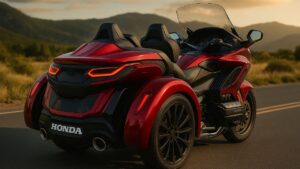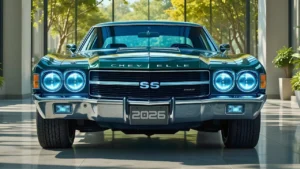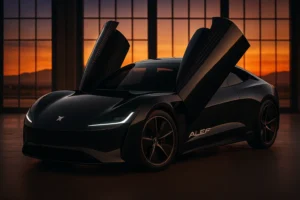In the world of ultra‑luxury performance cars, few models generate as much buzz as the new Bugatti Tourbillon, announced in mid‑2024 and set for 2026 delivery. This vehicle is more than a successor to the legendary Chiron—it represents the next chapter for the brand, combining a dramatic new powertrain, exquisite craftsmanship, and extreme rarity. For collectors and car enthusiasts globally, the Tourbillon is not just a car—it’s an icon in the making.

2026 Bugatti Tourbillon Hypercar: Overview
| Category | Details |
|---|---|
| Model Name | Bugatti Tourbillon (2026) |
| Production Limit | 250 units |
| Starting Price | Approximately US$4.6 million |
| Powertrain | 8.3 L naturally aspirated V16 + three electric motors (hybrid) |
| Combined Output | Around 1,800 horsepower |
| 0–60 mph Time | Approximately 2.0 seconds |
| Top Speed | Electronically limited ~445 km/h (≈276 mph) with optional “Speed Key” |
| Electric‑only Range | Approximately 30–37 miles (≈50–60 km) |
| Launch/Delivery | Revealed June 2024; deliveries begin 2026 |
| Design Philosophy | Luxury, performance and timeless craft inspired by horology |
Introduction to the Model Bugatti Tourbillon Hypercar 2026
Bugatti’s Tourbillon marks a major shift. For nearly two decades, the brand’s flagship cars—such as the Veyron and Chiron—used turbocharged W16 engines. The Tourbillon abandons that in favour of a brand‑new architecture: a naturally aspirated V16 combined with electric motors and a high‑voltage hybrid system. According to Bugatti CEO Mate Rimac, the aim was to deliver “a car which is beautiful inside and outside… the most powerful Bugatti to date.”
Moreover, the name “Tourbillon” is a nod to high‑end Swiss watchmaking, signalling the brand’s intent to combine mechanical art with automotive performance. The production run is extremely limited—only 250 examples worldwide—ensuring exclusivity.

Key Features of the Car
- Powertrain Innovation: The Tourbillon pairs an 8.3‑litre V16 NA engine (developed with Cosworth) with three electric motors—yielding nearly 1,800 hp.
- Hybrid Architecture: A high‑voltage system (800 V architecture) and a battery pack of roughly 20–25 kWh power the electric motors. Electric‑only mode offers around 30‑60 km of range.
- Performance Numbers: The 0–60 mph time is about 2 seconds, with 0–300 km/h (186 mph) estimated in around 10 seconds. Top speed is claimed to be up to 445 km/h (≈276 mph) when unlocked.
- Design & Craftsmanship: From 3D‑printed suspension components to crystal glass and titanium instrument cluster, the car blends cutting‑edge tech with artisan detail.
- Limited Production & Price: With only 250 units and a starting price around US$4.6 million, the Tourbillon is targeted at ultra‑high‑net‑worth collectors.
- Brand Heritage: Bugatti emphasises legacy: “If comparable, it is no longer Bugatti,” as the brand leadership states.
Who Can Buy this Car?
While this isn’t a “program” in the usual sense, for interested buyers the considerations are:

- Membership & invitation: Bugatti typically allocates cars via its client programme; potential buyers must be approved.
- Financial qualification: With a starting price above US$4 million plus taxes, only established collectors will qualify.
- Regional restrictions: Deliveries will happen in limited markets; local import duties/registration may vary by country.
- Order timing: Early reservation is essential given the 250‑unit limit; options and customisation fill quickly.
What Makes 2026 Bugatti Tourbillon Hypercar Model Stand Out?
- Performance supremacy: Among the fastest production cars ever conceived.
- Exclusivity: Only 250 units worldwide ensures rarity and future value potential.
- Hybrid innovation: Combines analogue engine thrill with electric support—bridging the best of both worlds.
- Craftsmanship & luxury: Interiors and materials reach art‑car level, appealing to connoisseurs of both cars and watches.
- Collector appeal: With strong brand heritage and limited production, the Tourbillon is expected to become a milestone piece.

2026 Bugatti Tourbillon Hypercar Price
| Item | Details |
|---|---|
| Base Starting Price | Approx. US$4.6 million |
| Currency & Regions | Global; pricing may vary by country due to taxes and duties |
| Deposit / Reservation | Likely significant deposit required to secure the allocation |
| Customisation & Sur Mesure | High‑end bespoke options available at extra cost |
| Delivery Timeline | Orders accepted in 2024/25 -> Deliveries begin 2026 |
| Ownership Costs | Maintenance, insurance, import duties will all be elevated given rarity |
Even though official payment terms are not fully public yet, given Bugatti’s previous limited‑edition models, clients will be required to commit early, approve bespoke options and await delivery in the later phase of 2026.
Comparison in Between the Bugatti Models?
| Category | Bugatti Tourbillon | Previous Bugatti Chiron Supersport+ |
|---|---|---|
| Engine / Powertrain | 8.3 L NA V16 + three electric motors (~1,800 hp) | Quad‑turbo W16 (~1,500 hp) |
| Production Volume | 250 units | Larger run (~500+ in some variants) |
| Starting Price | ~US$4.6 million | ~US$3–3.5 million (depending on variant) |
| Electric / Hybrid Capability | Full hybrid PHEV architecture, e‑only range ~30–60 km | Primarily combustion, minimal electric means |
| Design Focus | Art‑car level craftsmanship + extreme speed | High performance luxury, less bespoke detail |
Insight: The Tourbillon isn’t just faster—it’s more advanced in every dimension: powertrain, materials, exclusivity, and luxury. It marks an evolutionary leap, not just incremental improvement.

Recent Updates
- June 2024: Bugatti officially revealed the Tourbillon in online presentation, confirming V16 hybrid powertrain and 250‑unit limit.
- October 2025: Bugatti published design‑focused press release highlighting new aerodynamics and 3D‑printed components in the Tourbillon.
- August 2025: Pricing and specs further detailed by third‑party outlets, confirming horsepower near 1,775–1,800 hp.
Why It Matters?
The Tourbillon matters because it signals a paradigm shift in hypercars. It pushes beyond simply “faster” into “architecture redefined.” For high‑net‑worth individuals and automotive collectors, it represents the cutting edge of engineering, design and luxury. In an age where many marques focus on high‑volume EVs, Bugatti doubles down on ultra‑low volume, artful performance vehicles—underscoring the enduring value of bespoke, high‑performance craftsmanship.
From a broader perspective, the Tourbillon demonstrates how legacy brands can adapt: merging combustion heritage with electrification, artisanal detail with modern materials, exclusivity with performance. It may not directly impact most drivers—but in the world of luxury collector vehicles, it sets the tone for what is possible.
“We wanted someone to be able to take any piece of this car — inside, outside or under the skin — and believe that it could be placed in an art gallery.” — Mate Rimac (Bugatti CEO)
“Everything is playing hand in hand. The new package, the design — we really showcased the capabilities of what the Tourbillon can do.” — Jan Schmid (Bugatti Chief Exterior Designer)
“None of what we have achieved with the Tourbillon are easy things to do. They’re only possible if you implement this kind of strategy from the very first pencil stroke.” — Frank Heyl (Bugatti Director of Design)
FAQs
How many Bugatti Tourbillons will be built?
Only 250 units globally, making it extremely limited.
What is the starting price?
Approximately US$4.6 million, though final cost depends on customisation and region.
What kind of engine does it have?
An 8.3‑litre naturally aspirated V16 combined with three electric motors in a hybrid configuration.
What performance can be expected?
Around 0–60 mph in ~2.0 seconds and top speeds in excess of 300 mph, with some speculating 445 km/h (~276 mph).
Is this car purely electric?
No. It is a hybrid that merges a combustion engine and electric power—offering an electric‑only range but fundamentally high‑performance.
When will deliveries start?
Deliveries are expected to begin in 2026 after the production run opens following the 2024–25 ordering phase.

